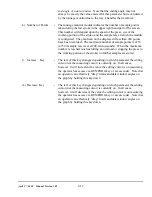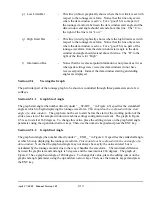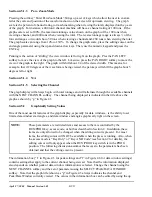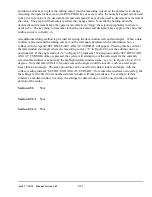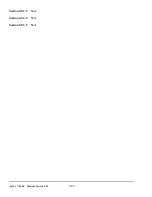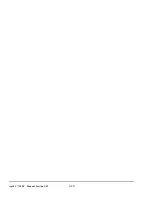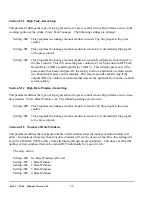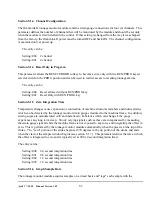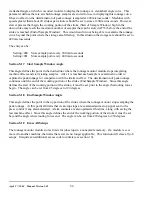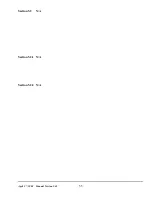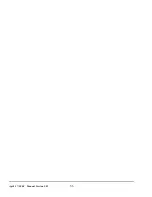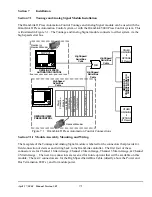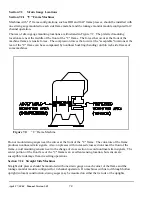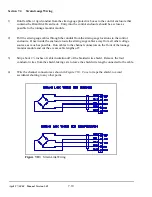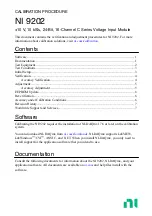
April 27, 2004 Manual Version 1.01
5.5
Section 5.2
N/A
Machine Rating
This selection displays the screen shown in Figure 5.3. Changes are made with the RUN/PROG keyed
selector switch in the PROG position by positioning the cursor onto the desired parameter with the arrow
keys, using the numeric keypad to set a new value, and pressing the ENT key or through the softkeys
provided.
The Machine Rating is the total capacity of the machine frame as defined by the press manufacturer and
is typically specified at some position off the bottom of the stroke. The tonnage monitor will use this
parameter along with the number of channels to determine the rating of each channel. The scale factors
calculated are used to translate strain gauge outputs into tonnage values. This value should be set at the
time that the tonnage monitor module is installed and not changed afterward.
Section 5.2.1 N/A
Decimal Point
The tonnage monitor module can measure and display tonnages 150% greater than the machine rating.
A machine rating greater than about 660 tons could not show the entire measurable range with a display
format of 999.9. For machine capacities greater than this, the tonnage monitor module should be
formatted to display without the decimal point (9999). The format (decimal point position) is selected
by pressing the desired softkey.
Section 5.2.2 N/A
Derate Total Tonnage
A mechanical power press is typically specified by its manufacturer with a tonnage capacity rating and a
height off of the bottom of the stroke at which this rating applies. One reason for this is that an
mechanical advantage is created in the translation of rotary motion of the crankshaft to linear motion of
the slide that changes depending upon crankshaft angle. The constant torque of the clutch develops
more downward force as the crankshaft angle travels from 90 degrees (mid stroke) to 180 degrees
(bottom).
If torque were the only limiting factor, the press could deliver infinite tonnage at the bottom of the
stroke. However, the elastic limits of the press frame place an additional limitation near the bottom.
Below the point where the machine is rated, an absolute maximum limit of 125% of rated capacity is
placed on each strain gauge mounted to the machine frame in order to stop the machine before
permanent damage is done to the structural members. This limit is automatically set based on the
machine rating and the number of channels.
Above the point where the press is rated, an additional limit can be set so that the torque available from
the clutch is not exceeded. This torque is delivered to the entire machine frame and is measured by
examining only the total tonnage (combined tonnage on all frame members). Since the limit is placed on
the tonnage (and not directly measuring torque), it must decrease as crankshaft angle moves from 180 to
90 degrees (derates the machine rating). Tonnage curves are available from the press manufacturer that
describe the amount of total tonnage that can be developed at different points in the stroke.
If desired, the total tonnage can be derated by examining the press manufacturers' tonnage rating curve
for a particular type machine and entering this information into the tonnage monitor. The entry process
requires that the machine curve be divided into 16 discrete regions with a single tonnage limit that
applies for each region. Height off the bottom of the stroke must be converted to crankshaft angle in
Summary of Contents for OmniLink II
Page 5: ...April 27 2004 Manual Version 1 01 iv ...
Page 7: ...April 27 2004 Manual Version 1 01 1 2 ...
Page 21: ...April 27 2004 Manual Version 1 01 3 8 ...
Page 44: ...April 27 2004 Manual Version 1 01 4 23 Section 4 5 4 N A ...
Page 45: ...April 27 2004 Manual Version 1 01 4 24 ...
Page 69: ...April 27 2004 Manual Version 1 01 7 14 ...
Page 77: ...April 27 2004 Manual Version 1 01 8 8 ...



